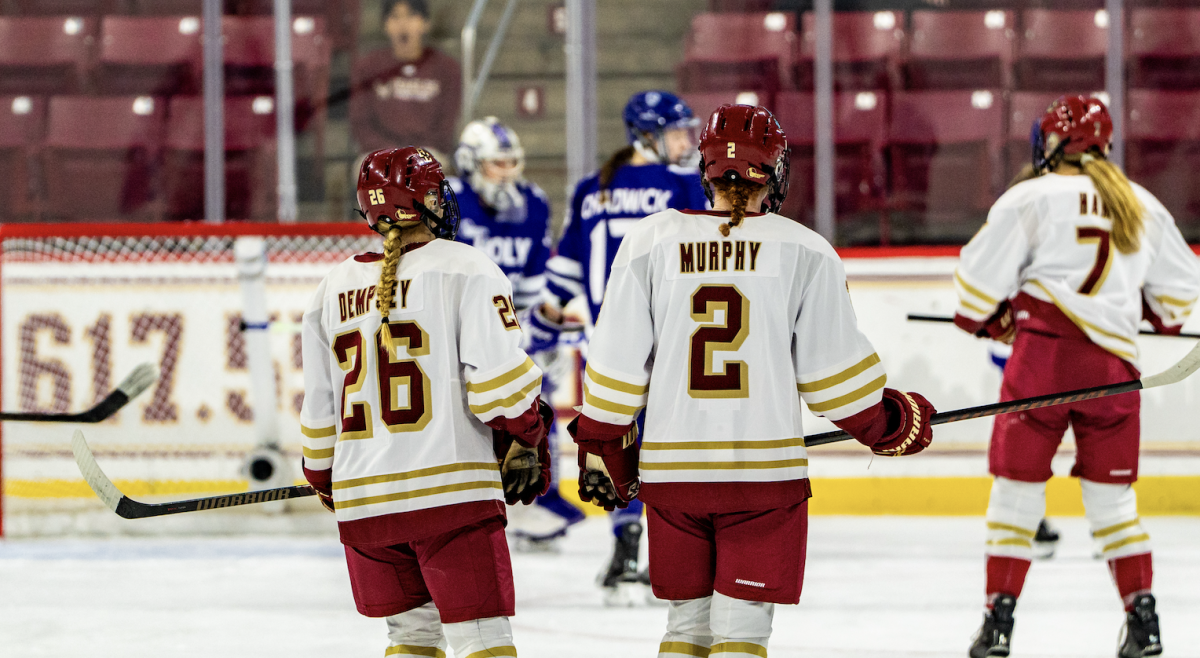The best indicator of a great team is its margin of victory. Boston College has the best goal differential in Division I college hockey and is driven by the best offense in the nation—a group that has racked up plenty of convincing, three-plus goal wins. Yet BC’s 3-1 victory—in which one goal was an empty netter—over a struggling Boston University on Monday night in the Beanpot semifinal may be just as good of a harbinger for the Eagles now that trophy season has arrived.
That’s because championship teams need to be able to win playing different styles and under different circumstances. The Eagles are one step closer to their fifth-straight Beanpot Championship because they displayed a capacity to do just that against a rival that was playing its best.
BC’s top line is the main force behind its offense—Johnny Gaudreau, Kevin Hayes, Bill Arnold, and the rest of the team showed how they can be dangerous without being explosive. The line’s center, Arnold, has been called the “best two-way forward in the country” by Hayes, and in the senior’s potentially last game against BU, he lived up to that reputation, supplementing his assists of Hayes and Gaudreau’s goals with relentless play in all three zones. That persistence can get Arnold in trouble at times—like it did when he received both of his penalties in an increasingly chippy game—but that edge is an invaluable part of his game and his team.
Gaudreau and Hayes especially are known for their offensive capabilities, but on Monday they were regulars again on the nation-leading penalty kill unit that held the Terriers without power-play goals on five tries. While Gaudreau padded his goal total with the empty netter, his and Hayes’ presence on the ice in the final minute with Arnold to protect their season’s most important lead to date exemplifies York’s trust in them to do more than fill up the box score.
Just as BC’s offensive contributions go beyond its three Hobey Baker candidates, so did its defense Monday. After the game, head coach York credited goaltender Thatcher Demko for much of the defensive effort, but the Eagles played quality team defense throughout the night.
Even as the goal-starved Terriers ripped shots at Demko, there were few breakdowns that led to tantalizing chances for BU’s offense. More importantly, many of those shots came from less-than-ideal shooting positions.
The other aspect of BC’s team defense Monday night was that the Eagles got contributions throughout the roster. Senior captain Patrick Brown played his normal defensively responsible game and preserved BC’s two-goal lead with about seven minutes left in the second period when he fought off Terriers forward Tommy Kelley and cleared a puck in the crease that Demko lost track of.
Freshman defenseman Scott Savage, playing increased minutes due to Ian McCoshen’s absence, had one of his best two-way games of the season as well, which was highlighted by great hustle to break up what was a Terrier 2-on-0 rush just after Brown made his own goal-saving play.
Savage’s performance underlined another underrated dimension to York’s team: its depth. “They’re deep at all three positions: in the nets, on the blue line, up front,” said BU head coach David Quinn after the game.
Quinn knows the value of what he speaks, because in place of injured BU defenseman Matt Grzelyck—McCoshen’s defensive partner at World Juniors—was freshman T.J. Ryan, a converted forward who showed his inexperience on the back end Monday. Worse, Quinn paired Ryan with senior Garrett Noonan at times against BC’s best forwards, because roster limitations left him no choice.
Compounding that depth is a physicality that seems to contradict what York’s teams are often known for. Steve Santini set the tone on the first shift of the game by checking BU forward Mike Moran—only one of two Terrier forwards whose weight resides near Santini’s 201 pounds—right in front of the bench. That tone was maintained without the menacing McCoshen because of a cumulative size that belies a typical York team. Even the forward group, where BC has gained its diminutive reputation in the past, features a depth line of Destry Straight (6-foot-1), Adam Gilmour (6-foot-3) and Chris Calnan (6-foot-2).
“They’re big,” Quinn said. “They’re huge. I mean, the days of people talking about the small BC teams, throw that right out the window. You look at their lineup, and they are big. And they are heavy, and they compete.”
Even before Santini made his mark, Quinn Smith, a player who embodies all of the ignored qualities of the No. 2 team in the country, careened into the right corner of BU’s end just after puck drop and discarded BU defensemen Dalton MacAfee and Doyle Somerby in one fell swoop to gain possession. Smith is just 5-foot-8, but he is perhaps BC’s most physical forward and plays way above his listed weight of 166 pounds. He’s potted only two goals on the season, but he has dressed for as many games as Gaudreau because of his tireless work on the penalty kill and in his own zone.
It’s easy to get lost in Gaudreau’s magical stick work or Hayes’ transformation into an All-American power forward. York himself even remarked, when pressed regarding his team’s overall defensive game, “It’s fun to watch Johnny G, isn’t it?”
Another four-goal win powered by some more ridiculous stats from that top trio would have been fun for York and his team, certainly. It’s doubtful that he minded this one, though, and not just because it was the Beanpot.
Featured Image by Emily Fahey / Heights Editor












